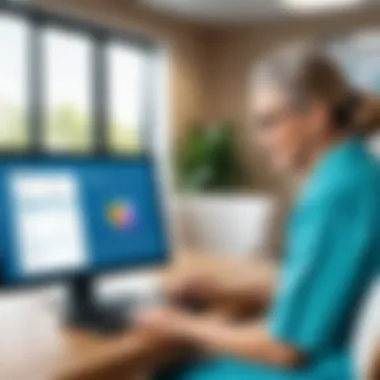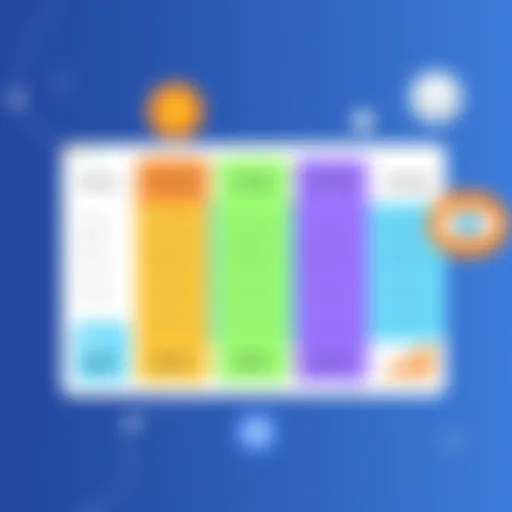Understanding Skilled Nursing Facility Software


Intro
In the landscape of healthcare, skilled nursing facilities are essential for the well-being of patients requiring specialized care. The role of skilled nursing facility software in these environments cannot be overstated. This software embodies a blend of operational support and clinical oversight, ultimately working to improve both patient outcomes and staff efficiency.
As the health sector evolves, the integration of technology is a key factor driving advancements. Stakeholders must understand how this software functions and its implications for operational processes. The objective of this article is to explore the intricate dynamics at play in skilled nursing facility software, covering essential components as well as emerging trends.
Software Category Overview
Purpose and Importance
Skilled nursing facility software serves a multifaceted purpose within healthcare. Primarily, it aids in managing day-to-day operations, including patient admissions, scheduling, billing, and care planning. The importance of this software lies in its ability to streamline administrative tasks, enabling staff to focus on patient care. Moreover, the software's data analytics capabilities can enhance decision-making processes by offering insights into patient demographics and health trends.
Skilled nursing facility software is a critical tool that shapes the quality of care delivered to patients, making effective management crucial for operational success.
Current Trends in the Software Category
The skilled nursing facility software market experiences constant evolution, influenced by technological advancements and regulatory changes. Key trends include:
- Telehealth Integration: Providers increasingly utilize telehealth functionalities to offer remote consultations, which improves access to care.
- Mobile Compatibility: Mobile applications enable staff to access patient information and perform tasks on-the-go, enhancing efficiency.
- AI and Machine Learning: These technologies aid in predictive analytics, helping facilities prepare for patient needs before they arise.
Understanding these trends equips stakeholders to better evaluate their options and adapt to an ever-changing environment.
Data-Driven Analysis
Metrics and Criteria for Evaluation
When evaluating skilled nursing facility software, a data-driven approach is essential. Metrics such as user satisfaction, ease of integration, and regulatory compliance should be key factors in the selection process. The evaluation should consider:
- Interoperability: The ability of the software to communicate with other systems is vital for seamless operations.
- Scalability: As health facilities grow, the software should accommodate increased volume without performance issues.
- Cost-effectiveness: While feature-rich solutions may seem appealing, stakeholders must assess ongoing costs against budget constraints.
Comparative Data on Leading Software Solutions
Comparative analyses can shed light on the effectiveness of various skilled nursing facility software solutions. Leading providers include:
- PointClickCare: Known for its cloud-based features, it offers robust reporting and strong billing functionalities.
- MatrixCare: This solution provides comprehensive management tools and is widely recognized for its user-friendly interface.
- AOD Software: With specific focus on skilled nursing facilities, it stands out for its regulatory compliance features.
Deciding on the best software requires a detailed evaluation process that involves comparisons and thorough understanding of individual business needs.
In synthesis, the exploration of skilled nursing facility software offers vital insights into improving operational efficiency and patient care within the sector. Identifying key trends and conducting a data-driven analysis are vital steps in making informed decisions.
Prelims to Skilled Nursing Facility Software
Definition and Purpose
Skilled nursing facility software refers to a specialized system designed to manage various operational and clinical functions within long-term care settings. The primary purpose of this software is to support facilities in handling patient information, scheduling, billing, and regulatory compliance.
This software integrates essential tasks into one platform, ensuring that staff can access patient records, appointment schedules, and billing details efficiently. Moreover, with a centralized database, it minimizes errors that could arise from manual processes, fostering an atmosphere of safety and accuracy in patient care.
Importance in Healthcare Management
In the context of healthcare management, skilled nursing facility software plays a crucial role. Firstly, it enhances operational efficiency. Staff can manage their time and resources better, which ultimately leads to improved patient care. The software also provides data analytics, allowing administrators to monitor performance metrics and make informed decisions about resource allocation.
Furthermore, regulatory compliance cannot be overlooked. The healthcare industry is rife with rules that facilities must adhere to, and failure to comply can result in penalties. Skilled nursing facility software is designed to help organizations maintain compliance with these regulations by keeping accurate documentation and monitoring performance against required standards.
"Effective management through technology can not only streamline services but also elevate the level of care provided to patients."
Key Features of Skilled Nursing Facility Software
Understanding the key features of skilled nursing facility software is crucial for grasping how such tools can transform healthcare management. The effective integration of these features can streamline operations, enhance patient care, and ensure compliance with industry regulations. Each component plays a significant role in addressing specific organizational needs. Therefore, a deep dive into these features reveals not only their individual importance but also how they collectively contribute to a facility's overall efficacy.
Patient Management
Patient management is at the heart of skilled nursing facility software. This feature enables facilities to maintain comprehensive patient records, including medical history, treatment plans, and discharge summaries. With intuitive user interfaces, healthcare providers can quickly access patient information, which is essential for timely and effective care. Additionally, such software often includes tools for scheduling appointments, tracking medication adherence, and monitoring health outcomes. The ability to efficiently manage patient data not only enhances care quality but also improves communication among staff members, fostering a more cohesive work environment.


Billing and Revenue Cycle Management
Billing and revenue cycle management are critical for the financial health of skilled nursing facilities. The software allows for accurate billing processes, automating claims submissions to Medicare and Medicaid. This automation minimizes errors and reduces the time spent on manual billing tasks, which can lead to faster payments. Understanding the intricacies of the billing cycle, from patient admission to final payment, is essential for financial sustainability. Key elements include tracking patient insurance coverage, managing accounts receivable, and generating financial reports to analyze revenue trends. This feature empowers facilities to optimize cash flow and minimize financial risks.
Staff Scheduling and Management
Efficient staff scheduling and management ensure that skilled nursing facilities maintain an adequate workforce to meet patient needs. The software facilitates roster creation, shift swapping, and attendance tracking, allowing managers to quickly fill gaps and prevent staffing shortages. It can also integrate with payroll systems to streamline compensation processes. Additionally, intelligent scheduling tools can analyze workload patterns, helping managers make informed decisions about staffing levels. This capability is crucial in ensuring that the facility can provide consistent patient care while managing operational costs effectively.
Clinical Documentation and Compliance
Clinical documentation and compliance functionalities ensure that facilities adhere to regulatory requirements and maintain high standards of care. The software aids in capturing accurate and thorough clinical notes, reducing the risk of legal issues. Features may include templates for assessments, treatment plans, and progress notes. Additionally, the software may facilitate real-time compliance checks against state and federal regulations. By maintaining up-to-date documentation, facilities can foster transparency and accountability while protecting themselves against potential audits and penalties.
Reporting and Analytics
Reporting and analytics capabilities offer valuable insights into the operations of skilled nursing facilities. With real-time data reporting, administrators can track key performance indicators, patient outcomes, and financial metrics. This information is critical for making data-driven decisions that enhance facility operations. The software often includes customizable dashboards that allow users to focus on the metrics most relevant to their goals. Analyzing trends over time can lead to improvements in patient care, operational efficiency, and financial performance.
"Data drives decisions. In healthcare, understanding the numbers can improve both care and operation."
Market Landscape of Skilled Nursing Facility Software
The market landscape of skilled nursing facility software plays a crucial role in the overall effectiveness of healthcare operations. It encompasses a variety of software solutions that are specifically designed to meet the unique needs of skilled nursing facilities. Understanding this landscape is essential for stakeholders in order to make informed decisions regarding the software they choose to implement. The right selection can enhance operational efficiencies, improve patient care, and ensure compliance with regulatory requirements.
In recent years, the increased demand for skilled nursing services has prompted many vendors to focus on developing advanced software solutions. Facilities now have access to various platforms that offer tailored functionalities, crucial for meeting specific operational demands. Evaluating major vendors and the current trends in software development is vital for navigating this complex market.
Major Vendors and Platforms
A deep dive into the major vendors in the skilled nursing facility software space reveals a diverse range of options available. Companies such as Cerner, MatrixCare, and PointClickCare dominate this market. Each vendor offers unique features and capabilities, catering to different types of facility needs. For example, Cerner focuses heavily on integrating electronic health records along with billing solutions, while MatrixCare offers extensive modules for care management and reporting.
Key Considerations When Choosing a Vendor:
- Functionality: Ensure the software meets specific operational and clinical needs.
- User Experience: Check if the interface is user-friendly for staff and administrators.
- Integrations: Look for compatibility with existing systems.
- Customer Support: Reliable support can aid in smooth implementation and troubleshooting.
Understanding these vendors can foster better decision-making for healthcare administrators, providing them with a clear view of what to expect in terms of functionality and service levels.
Trends in Software Development
The landscape of skilled nursing facility software is continuously evolving, shaped by emerging trends. Currently, certain trends stand out, influencing how software is developed and implemented in facilities.
- Cloud-Based Solutions: Many organizations are gravitating towards cloud-based platforms due to their flexibility and lower maintenance costs. This move allows for remote access, which is increasingly necessary in today's healthcare environment.
- Interoperability: With a growing emphasis on data sharing between different healthcare systems, interoperability has become a significant focus. Facilities need software that communicates seamlessly with other providers and systems.
- User-Centric Design: There is a push towards developing applications that prioritize user experience. Facilities are investing in systems that are intuitive, reducing training time and improving user adoption.
- Mobile Accessibility: The use of mobile applications is rising. Many vendors now offer mobile-friendly interfaces, allowing healthcare professionals to access necessary information on-the-go, which enhances responsiveness in patient care.
- Automation and AI: Integration of automation in routine tasks is gaining traction. This technology helps to improve accuracy and efficiency, particularly in billing and patient management systems.
As the skilled nursing facility software market continues to grow, embracing these trends is essential. Doing so not only enhances operational efficiency but also significantly impacts the quality of care delivered to patients.
"Adapting to these trends can set facilities apart, creating a more efficient and effective care environment."
Integrating Emerging Technologies
In the context of skilled nursing facilities, integrating emerging technologies represents a crucial step toward improving both operational efficiency and patient care. As healthcare continues to evolve through technological innovations, skilled nursing facility software must adopt these advancements to remain competitive and effective. This integration aids in streamlining various processes, allowing for better resource management and enhanced patient outcomes.
Telehealth Solutions
Telehealth has revolutionized patient care, especially in skilled nursing settings where mobility can be an issue. By employing telehealth solutions, facilities can offer remote consultations, which are effective in monitoring patient health without requiring unnecessary travel. This approach not only conserves resources but also makes healthcare more accessible for patients who may have difficulty attending in-person appointments.
The benefits of telehealth solutions include:
- Increased convenience for both patients and healthcare providers.
- Broader reach to specialists who might not be locally available.
- Reduced hospital readmission rates, as patients receive timely follow-up care.
Facilities integrating telehealth software often see improvements in overall patient satisfaction, driven by the enhanced availability of services. Additionally, many telehealth platforms offer built-in compliance with healthcare regulations, reducing administrative burdens.
Artificial Intelligence Applications
Artificial intelligence (AI) in healthcare has emerged as a transformative force, especially for skilled nursing facilities. AI applications can analyze vast amounts of patient data, leading to more efficient clinical decision-making. By integrating AI, facilities can identify patterns and predict potential health issues before they escalate, allowing for proactive care.
The deployment of AI in skilled nursing may involve:
- Predictive analytics for anticipating patient needs.
- Automated documentation which saves time for nursing staff.
- Decision support systems to provide evidence-based recommendations for care.


Moreover, AI can enhance resource allocation, enabling skilled nursing facilities to optimize staffing levels based on patient needs and adjusting care plans swiftly as conditions change. This leads to better patient outcomes and operational cost savings.
"The use of emerging technologies such as telehealth and AI not only improves service delivery but also sets skilled nursing facilities on a path toward sustainability in an increasingly competitive healthcare environment."
In summary, by integrating technologies like telehealth and artificial intelligence, skilled nursing facilities can significantly improve their operations while enhancing the quality of care provided to their patients.
Regulatory Compliance and Legal Considerations
Regulatory compliance plays a crucial role in the context of skilled nursing facility software. Compliance ensures that software systems meet established legal and ethical standards, which are essential for protecting patient information and providing high-quality care. Facilities must navigate a complex landscape of compliance requirements that include federal, state, and local laws. Engaging with these regulations not only safeguards patient data but also enhances the organization’s credibility in the healthcare sector.
Understanding HIPAA Regulations
The Health Insurance Portability and Accountability Act (HIPAA) is a cornerstone of patient privacy in the United States. HIPAA establishes standards for protecting sensitive patient information. All skilled nursing facility software must comply with these regulations, ensuring that any electronic health records (EHR) or other patient data are secured against unauthorized access. Key elements of HIPAA include:
- Privacy Rule: This governs the use and disclosure of protected health information (PHI).
- Security Rule: This mandates safeguards to protect electronic PHI from being accessed by those not authorized.
- Breach Notification Rule: Requires organizations to notify patients and the Department of Health and Human Services in case of a data breach.
A robust understanding of HIPAA helps skilled nursing facilities choose software that not only meets operational needs but also conforms to legal obligations, reducing the risk of expensive fines and legal actions.
State-Specific Regulations
In addition to federal regulations like HIPAA, skilled nursing facilities must also adhere to state-specific laws and regulations. These state laws can vary widely and may impose additional requirements regarding patient care, staff training, and technology use. Examples of state-specific regulations include:
- Licensing Requirements: Each state has specific rules for licensing healthcare facilities that must be adhered to, ensuring that the software can accommodate these needs.
- Reporting Standards: Some states require facilities to report certain patient outcomes or incidents, demanding software capabilities that support these functions.
- Patient Rights Laws: These laws advocate for transparency in patient care and give patients rights over their own health information.
Failure to comply with state regulations can impact funding, affect patient trust, and result in serious legal repercussions.
In summary, compliance with HIPAA and state laws is not optional for skilled nursing facilities; it is a foundational aspect of operational integrity and legal protection.
Understanding and implementing these regulatory frameworks are vital for the effective use of skilled nursing facility software. The careful selection of compliant software can significantly mitigate legal risks and support facilities in providing top-notch care.
Financial Implications of Skilled Nursing Facility Software
The financial implications of skilled nursing facility software are profound and multi-faceted. Understanding these aspects is crucial for administrators aiming to enhance operational efficiency while controlling costs. The effectiveness of such software goes beyond mere tool functionality; it also includes its value in cost-saving, revenue generation, and overall return on investment.
Cost Analysis
When evaluating the cost of skilled nursing facility software, it is vital to consider both direct and indirect expenses. Direct costs often include licensing fees, installation expenses, and ongoing maintenance costs.
- Licensing Fees: Many software systems operate on a subscription model. This requires facilities to budget for recurring payments. Evaluating various licensing structures can reveal opportunities for cost savings.
- Implementation Costs: Initial setup costs can be significant and may require budgeting for IT personnel involvement or additional resources to train staff effectively.
- Support Costs: Ongoing support is critical. Some facilities overlook the potential need for additional technical assistance, which can significantly impact overall costs.
- Training Expenses: Investing in staff training is essential for maximizing software capabilities. Neglecting this can lead to underutilization, resulting in lost efficiency and increased operational costs.
The cost analysis should factor in potential savings from streamlined processes. For example, time saved through automated billing and patient scheduling can translate into labor cost reductions, providing a more comprehensive view of total expenses.
Return on Investment
The concept of return on investment (ROI) is fundamental when assessing skilled nursing facility software. A well-chosen solution can deliver substantial financial benefits that justify the initial expenditures.
ROI can be evaluated through several lenses:
- Operational Efficiency: Enhanced workflows allow for quicker patient processing and reduced administrative burdens. This efficiency can lead to increased capacity to handle more patients without adding staff.
- Improved Revenue Cycle Management: Effective billing and revenue tools can decrease days in accounts receivable. Quicker payment cycles improve cash flow and financial stability.
- Reduction in Compliance Risks: With integrated compliance tracking, facilities can avoid costly penalties associated with non-compliance. This proactive approach can save money in the long run, providing an additional ROI facet.
- Resilience Against Market Changes: Investing in robust software enables facilities to adapt quickly to changes in regulations, coverage requirements, and healthcare trends. This adaptability can help secure revenue streams that may otherwise face volatility.
In summary, both cost analysis and ROI evaluation are essential for understanding the financial implications of skilled nursing facility software. Each facility must conduct its assessments to determine how best to invest in these technologies, ensuring they support the organization's goals while optimizing expenditure.
"Investing in skilled nursing facility software is not merely a financial decision. It is a strategic move that can enhance operational capabilities, increase revenue, and greatly improve patient care."
By looking closely at both costs and returns, administrators can make informed decisions that align with their long-term financial strategies and quality care objectives.
User Adoption Strategies
The successful implementation of skilled nursing facility software is heavily reliant on effective user adoption strategies. These strategies not only support the technology integration but also maximize the benefits of the software for all stakeholders involved. Ensuring that staff adapts to the new system is critical. Robust user adoption can lead to enhanced patient care, better data management, and streamlined operations.
One of the significant aspects of user adoption is understanding the specific needs of the facility. Different staff members have varying degrees of technical proficiency and familiarity with software tools. Recognizing these differences allows administrators to tailor training programs that resonate with each group. This adaptability helps to foster a learning environment that encourages usage rather than resistance.
Training and Support
Comprehensive training is paramount in advancing user adoption. New software can often lead to anxiety among staff. Therefore, initiating a structured training program alleviates confusion and builds confidence. A blended approach to training, combining online resources with hands-on workshops, tends to be more effective. Users can learn at their own pace while also receiving direct support from trainers.


Ongoing support is equally important. Having a dedicated support team ensures that any questions or technical issues can be swiftly addressed. Continuous learning sessions that reinforce the use of specific features can keep staff engaged. Regular follow-ups to evaluate user comfort levels with the software foster an atmosphere where feedback is valued. This encourages open communication, as staff can express concerns or suggest improvements.
"Training and consistent encouragement can transform a skeptical staff into enthusiastic users of new technology."
Overcoming Resistance to Change
Resistance to change is a common hurdle when adopting new software in skilled nursing facilities. Staff may cling to established practices out of fear or uncertainty about the unknown. To effectively counter this resistance, it is essential to communicate the benefits clearly. Highlighting how the new software improves efficiencies, reduces manual tasks, and ultimately enhances patient care is crucial.
Engaging frontline staff in discussions about the software can help demystify the change. When users feel included in the decision-making process, it can reduce feelings of alienation. Providing testimonials from early adopters within the facility can demonstrate the software's practical advantages. Additionally, creating incentives for usage can motivate staff to embrace the change.
Adopting a phased rollout may also lessen the shock of transition. Gradually introducing the system allows staff to familiarize themselves at a manageable pace, decreasing the likelihood of overwhelming them. Measurable feedback sessions post-implementation can provide opportunities to adjust strategies, reinforcing a culture of growth and adaptability.
Case Studies and Real-World Applications
Case studies provide a valuable lens to examine the effectiveness and nuances of skilled nursing facility software. Their importance lies not just in showcasing successes but also in revealing the challenges and strategies employed by different facilities. In this section, we will explore successful implementations and the lessons learned from real-world applications.
Successful Implementations
Successful implementations of skilled nursing facility software are critical in understanding its role in enhancing operational efficiency and patient care. Several facilities have notably benefited from adopting this technology. For instance, a mid-sized nursing home in Florida integrated PointClickCare into their operations. They reported a 30% reduction in administrative workload, allowing staff to focus more on patient care. This transition involved a three-month plan, including extensive training for the staff and phased data migration.
The key benefits observed from this implementation included:
- Improved Communication: With centralized access to patient data, care teams communicated more effectively.
- Streamlined Billing: Automating billing processes helped reduce errors and delay in payments.
- Enhanced Compliance: The software helped ensure adherence to state and federal regulations by automating reporting.
Also, a large skilled nursing facility in California adopted MatrixCare. After six months, they reported improved patient outcomes, evidenced by a decrease in hospital readmissions. Their success stemmed from thorough user training and management buy-in at all levels.
Lessons Learned
The study of diverse case implementations reveals several key takeaways that facilities should carefully consider. These insights underscore the need for thorough preparation and continuous evaluation post-implementation.
- User Training is Essential: A common theme in successful case studies is the emphasis on comprehensive training programs. Staff members must feel comfortable with the new technology for optimal use. Facilities that offered ongoing training saw higher satisfaction rates and fewer errors.
- Phased Rollout: Not every facility can afford to implement the software all at once. Successful cases often employed a phased approach, gradually introducing features while assessing challenges and areas for improvement. This method can ease the transition and alleviate resistance among the staff.
- Feedback Loops: Establishing channels for user feedback enables continuous software improvement. Facilities that actively sought input reported higher engagement levels and a willingness to adapt the software to fit their unique workflows.
- Management Support: Strong leadership support is crucial for successful implementation. Management must prioritize the transition and foster an environment of adaptability and learning. This leadership ensures the whole facility is aligned with the goals of adopting new technology.
- Long-Term Evaluation: Finally, ongoing assessment post-implementation can measure success against defined benchmarks. Adjusting strategies based on performance data is essential for sustained success.
"The journey of software adoption is rarely linear. Facilities must remain agile and responsive to the evolving needs of both their staff and patients."
Future Trends in Skilled Nursing Facility Software
As the landscape of healthcare evolves, so does the technology that underpins skilled nursing facilities. Understanding future trends in skilled nursing facility software is essential for maintaining high standards of care and operational efficiency. The integration of advanced technology can lead to improved patient outcomes, better compliance with regulations, and cost savings. Facility decision-makers must be attentive to these trends in order to create strategies that align with both current and future demands in healthcare.
Predictions for Technology Adoption
The predictions for technology adoption in skilled nursing facilities are influenced by several factors, including regulatory changes, patient demographics, and advances in health tech. For a start, we are likely to see a continued expansion in the use of Electronic Health Records (EHRs). These systems streamline documentation and ensure that care providers have real-time access to patient data, which is vital for delivering coordinated care.
Furthermore, telehealth options will become more commonplace. With the rise of remote monitoring and consultations, facilities can provide timely intervention and reduce hospital readmission rates. Facilities that adopt telehealth can expect to enhance patient engagement and satisfaction, addressing a trend toward patient-centered care.
"Integrating technology is not just about compliance or efficiency; it’s about realigning healthcare practices to meet evolving patient needs." - Expert in Healthcare Technology.
Moreover, artificial intelligence will play a larger role in facilitating decision-making processes. Predictive analytics can optimize staffing levels, manage patient flow, and anticipate potential health risks. This integration of AI enables facilities to be proactive rather than reactive, streamlining operations and enhancing care quality.
Evolving Patient Needs
The needs of patients are continuously shifting, influenced by factors such as aging populations and increased chronic conditions. Future software solutions will need to address these evolving requirements. For instance, personalized care plans and individualized treatment strategies are becoming essential. Skilled nursing software must incorporate functionalities that allow for tailoring care to meet specific patient needs efficiently.
Similarly, the desire for enhanced communication among caregivers, patients, and families will grow. Software that facilitates seamless communication, such as portals where patients can access their health information and chat with providers, will gain significance.
In summary, skilled nursing facilities must adapt their software solutions to align with both advancements in technology and the shifting landscape of patient care preferences. Emphasizing technology adoption and a patient-centered approach will not only benefit facilities by improving efficiency and compliance but will also enhance the overall care experience for patients.
Closure
The conclusion of this article brings together various critical elements discussed surrounding skilled nursing facility software. Understanding the essence of this software is paramount, not just for operational efficiency but also for better patient care. In a fast-evolving healthcare environment, this software contributes significantly to achieving compliance, enhancing management processes, and addressing financial challenges.
Summary of Key Insights
Skilled nursing facility software serves as a vital tool that streamlines operations within such institutions. Key insights include:
- Patient Management: This aspect ensures that patient data is accurately recorded and easily accessible, which can significantly impact care quality.
- Billing Mechanisms: An efficient billing system optimizes revenue cycles. Accurate billing processes mitigate delays in payment, thus maintaining financial stability.
- Regulatory Compliance: Understanding HIPAA regulations and state-specific laws is crucial. Compliance minimizes the risk of legal issues, providing peace of mind to management.
- Integration of Technology: Technologies like telehealth and artificial intelligence are transforming care delivery. These innovations are not just trends but essential components for future sustainability.
Final Recommendations
Final recommendations for stakeholders considering skilled nursing facility software include:
- Conduct Thorough Needs Assessment: Before selecting software, a detailed analysis of operational needs will ensure the chosen solution fits effectively.
- Prioritize User Training: User adoption strategies should involve comprehensive training sessions. Ensuring staff are well-versed in software operation can lead to higher efficiency.
- Focus on Integration Features: Opt for platforms that offer seamless integration with other essential systems, enhancing overall functionality.
- Stay Updated on Compliance Trends: Regularly monitor changes in regulations to maintain compliance and avoid penalties, safeguarding the facility.
- Evaluate Long-Term ROI: Consider both direct and indirect cost savings over time. Investments in quality software can significantly influence the facility's operational success.







